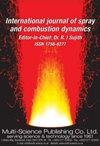剪切-同轴喷油器流体动力学对典型低温火箭发动机高频燃烧不稳定性的影响
IF 2.1
4区 工程技术
Q3 ENGINEERING, MECHANICAL
International Journal of Spray and Combustion Dynamics
Pub Date : 2022-03-01
DOI:10.1177/17568277221093848
引用次数: 5
摘要
详细研究了欧洲低温火箭发动机具有代表性运行条件的42元件研究火箭推力室中热声不稳定性的激发机制。从先前的研究中已知,室1T模式可以由持续的热释放速率振荡激发,该振荡由液氧喷射器的谐振模式调制。本文研究了纵向喷射器本征模的激发源。从两个注射器的凹陷体积测量OH*动力学的光纤探针显示出额外的频率含量,这既不能用腔室声学来解释,也不能用注射系统的声学来解释。相反,这些频率的时间演变与氧化剂流速相关。在这项工作中,我们表明额外的火焰调制源于喷射系统中的流体动力学效应。尽管无法精确确定确切的过程,但在喷射器入口孔处吹口哨的效果指定孔似乎是一个可能的候选者。将新的结果与之前关于该燃烧器的出版物相结合,现在可以根据出现燃烧不稳定性所必需的流体动力学和热声条件来解释过去和现在的观测结果。导致1T模式的喷射驱动激励的条件是喷射器的2L模式和腔室1T模式匹配的频率,以及基于喷射器入口孔的长度和流速在0.2和0.4之间的斯特劳哈尔数。本文章由计算机程序翻译,如有差异,请以英文原文为准。
Impact of shear-coaxial injector hydrodynamics on high-frequency combustion instabilities in a representative cryogenic rocket engine
The excitation mechanism of a thermoacoustic instability in a 42-element research rocket thrust chamber with representative operating conditions with respect to European cryogenic rocket engines is investigated in detail. From previous research it was known that the chamber 1T mode can be excited by persistent heat release rate oscillations which are modulated by the resonant modes of the liquid oxygen injectors. The excitation source of the longitudinal injector eigenmodes is investigated in this study. Fibre-optical probes measuring the OH* dynamics from the recess volume of two injectors showed additional frequency content which could neither be explained by the chamber acoustics, nor the acoustics of the injection system. Instead, the temporal evolution of these frequencies correlate with the oxidizer flow velocity. In this work we show that the additional flame modulation originates from a hydrodynamic effect in the injection system. Even though the exact process cannot be precisely identified, an effect designated orifice whistling at the injector inlet orifice seems to be a likely candidate. Combining the new results with previous publications about this combustor, it is now possible to explain past and present observations in terms of the hydrodynamic and thermoacoustic conditions which are necessary for the combustion instability to appear. The conditions, which lead to an injection-driven excitation of the 1T mode are matching frequencies of the 2L mode of the injectors and the chamber 1T mode as well as a Strouhal number between 0.2 and 0.4 based on the length and flow velocity of the injector inlet orifice.
求助全文
通过发布文献求助,成功后即可免费获取论文全文。
去求助
来源期刊

International Journal of Spray and Combustion Dynamics
THERMODYNAMICS-ENGINEERING, MECHANICAL
CiteScore
2.20
自引率
12.50%
发文量
21
审稿时长
>12 weeks
期刊介绍:
International Journal of Spray and Combustion Dynamics is a peer-reviewed open access journal on fundamental and applied research in combustion and spray dynamics. Fundamental topics include advances in understanding unsteady combustion, combustion instability and noise, flame-acoustic interaction and its active and passive control, duct acoustics...
 求助内容:
求助内容: 应助结果提醒方式:
应助结果提醒方式:


